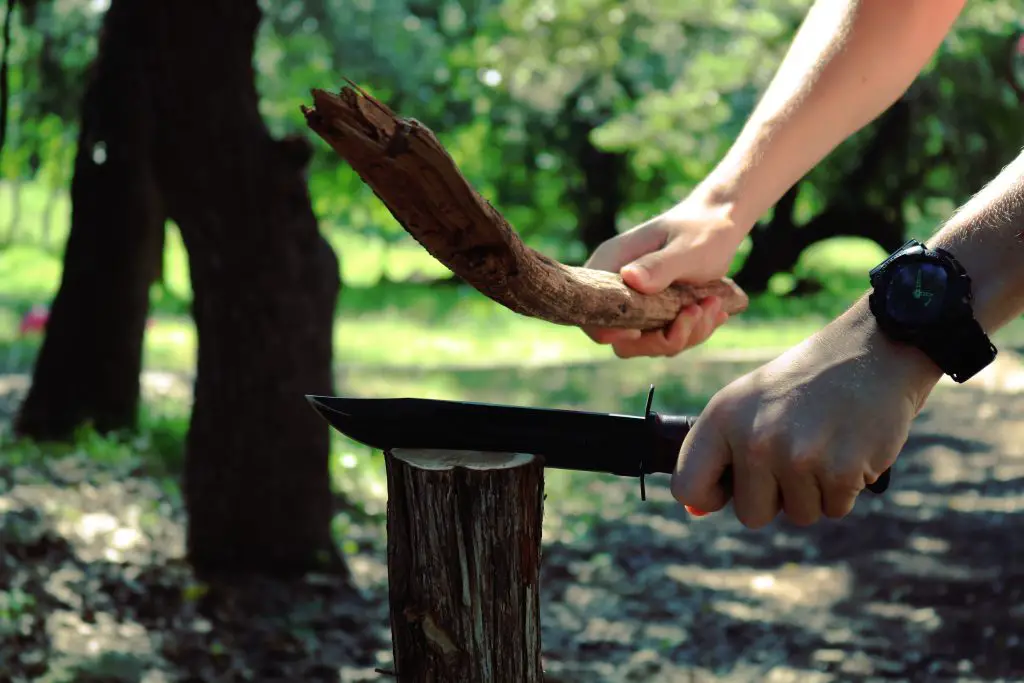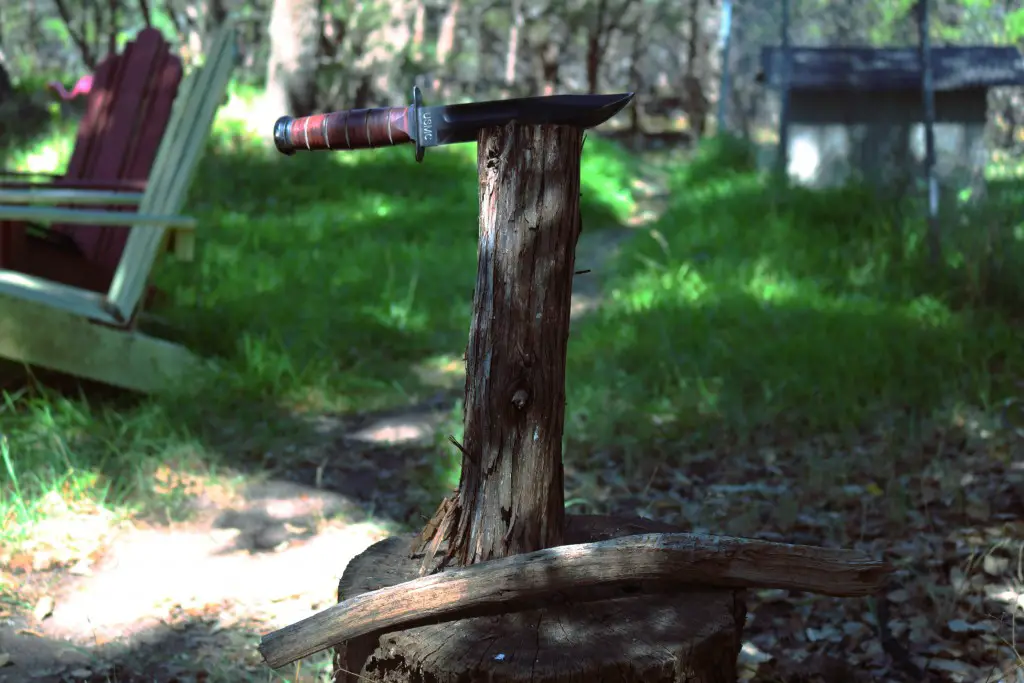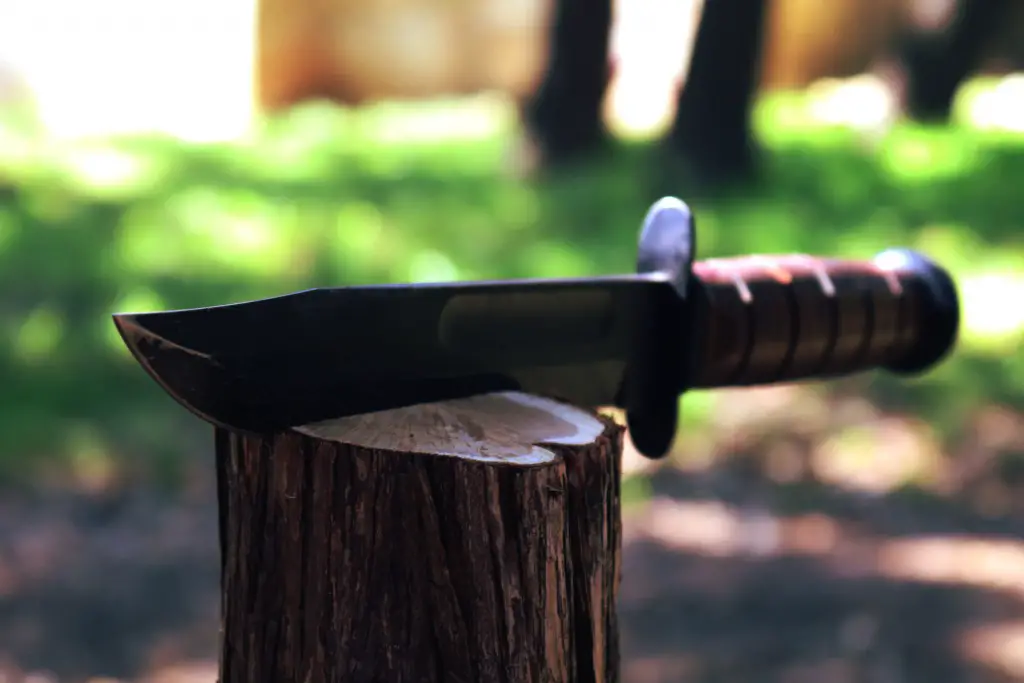Many people agree that cutting wood with a saw or hatchet is exhausting and time-consuming. That’s why many people are turning to a technique called batoning to complete their small wood chopping needs. Batoning is a simple way to quickly split small wood without using much energy or time. Because we all know that conserving energy is both awesome because your not as tired, and could save your life in a survival situation.
But before I tell you how to correctly baton wood so that you don’t hurt your knife or yourself, let’s take a look at what exactly batoning is.
Table of Contents
What is Batoning?
Batoning wood with a knife is the act of placing a knife on a piece of wood and using a baton to pound on the knife so that the wood spits.

The materials used to baton wood will depend on what you have available and where you are in the world. But in many survival cases, the baton used would be a small log or heavy stick. Any other material used as a baton will often hurt or snap your knife when you are batoning. I suggest always sticking to wood as a baton just to be safe.
Be aware, this technique is only good for splitting small logs or pieces of wood. Because you are using your knife to split the wood, the piece of wood you are splitting can only be as wide as your knife blade is long.
This technique is often used and can be an invaluable skill to learn for survival purposes. It can be used to not only split firewood but also to make other useful survival tools such as traps. Once you learn how to properly baton wood, it unlocks a world full of other survival tools that you can make with relative ease.
How to Baton Wood the Correct Way

Materials you will need:
- A full tang, fixed blade knife
- A small log to chop
- A large stump or another wooden surface
- A solid, 12-inch long stick or small log
- Gloves and eye protection (optional)
Go outside and find a steady stump or another wooden surface that you don’t mind getting ruined and slashed with a knife. Place your small log that you are going to chop on the surface. Turn your log that you are going to chop on its end so that the end of the log where it was cut down is facing upward.
Next, hold your knife in your opposite dominant hand and your baton in your dominant one. Place your knife over where you want to split the log and position the blade so that it is perpendicular to the surface you are about to chop.
Lightly tap the back of your knife blade with your baton to dig the blade into the wood a little. Then, increase the strength of your blows on the blade until your knife is so far into the wood so that you can’t hit the center of the blade anymore.
Then, continue to force the blade through the wood by hitting the tip of the knife and then where the blade meets the handle of the knife. Alternate hitting these two places until you work your knife so far into the log that it splits.
Tips and Tricks for Batoning Wood
The first few times you baton wood with a knife, it’s going to be terrible. It’s just a learning curve to mastering this useful skill. But keep trying and you’ll get it eventually.
You also have to understand that batoning is very different from cutting or sawing wood. When you saw a piece of wood, you are in complete control over where the cut goes. When you baton, things are a bit different.
While you still have some level of control, the blade will split the wood along the grain of the log. This will often result in a curved split or a split that goes off in one direction and doesn’t make it to the end of the log. It’s just the way it goes.
While it is possible to work hard and learn from trial and error, here are a few tips on batoning that will hopefully help you avoid some mistakes and technique errors. Trust me, I learned the hard way and made all of these mistakes.
Only try to split softer types of wood. While it is completely possible to split almost all types of wood, unless you’re in an extreme survival situation where you need a hardwood split, just stick with the softies. This will ensure you don’t break your knife or hit your blade too hard, slip, and slash yourself with your blade.
Another thing to look for in the wood you’re splitting are knots. Most knots in wood are near impossible to get through when your batoning. Avoid wood with them or at least avoid trying to split your wood through a knot in the log. It will save you a headache and a bunch of energy.
When your batoning, do it with your arms almost fully extended away from your body. It’s okay to have a little bend in your arms to provide more power to your swings, just don’t hug the wood. This will save you a finger and a lot of trouble in the long run if you listen to this advice.
Will Batoning Hurt my Knife?
If you do it right, no. If your dumb or don’t listen to the advice of people that have actually batoned wood before, yes, you can absolutely hurt and snap your knife while batoning.
There are two main mistakes that can hurt your knife when you are batoning wood. The first one is the surface that you put your wood on to baton it. Personally I only baton wood on wood. This is because any other material under the wood you are batoning can hurt your knife if you split the wood and your knife hits the surface.
Concrete, rocks, dirt, are not good options for a surface underneath the wood your batoning. All of those can either dull your blade, chip your knife, or both.
The second mistake that can hurt your knife while you are batoning is what material your baton is made out of. I’ve seen people on the internet using bricks, rocks, even cinder blocks as a baton. And let me tell you now before you follow their lead, don’t do it. Only use wood as a baton.
While there are probably half a dozen more ways to break or harm your knife while batoning wood, those were my top two mistakes that I’ve seen. If done properly, batoning should not harm your knife in any way. Just be smart about it and think before you act.
What Knives are Good for Batoning?

When I choose a knife with batoning specifically in mind, there are four main things that I look for. A good handle, no serration on the blade at all, a fixed blade, a full tang blade. To learn in-depth what knife tang is, check out this article.
A good handle that is easy to grip is almost non-negotiable. When you’re pounding on the blade of your knife with a stick, the only thing keeping that blade from flying away is you holding the handle. If the handle is hard to keep hold of, is painful to hold for some reason, or is too small, your going to have a tough time batoning wood.
The reason that I look for and will not use a serrated blade to baton wood, is that it just makes it more difficult than it should be. A serrated or partially serrated blade will try to dig into the wood instead of cleanly splitting the wood where you want it to. If there is any sort of serration on the top of your blade, it will slowly chew away at your baton. Both of these situations are not good, so just avoid them by using a knife with no serrations anywhere on the blade.
A fixed blade knife for batoning is necessary. This will ensure that your knife will not break from the repeated hits on its blade. Along with being a fixed blade, a full tang will provide the extra amount of strength and stability that your knife needs when you’re hitting the blade with a stick. With almost any other type of tang, your knife’s chances of snapping or breaking because of batoning increases by a lot.


